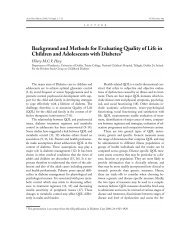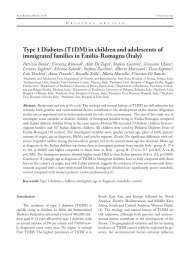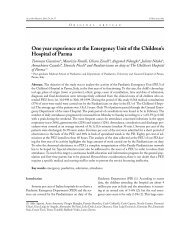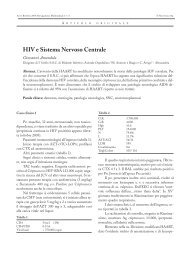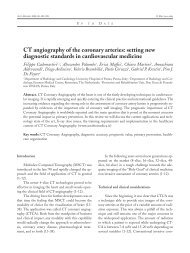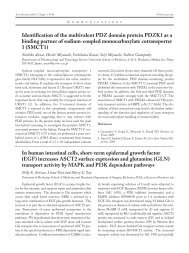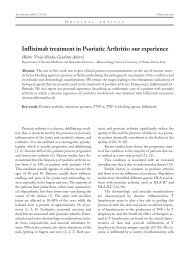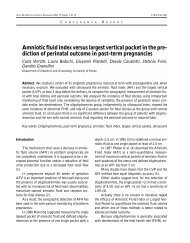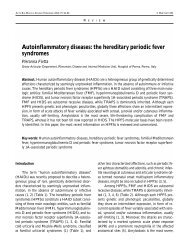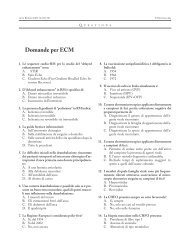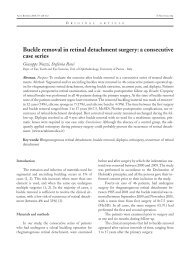Contribution of studies on renal effects of heavy metals and selected ...
Contribution of studies on renal effects of heavy metals and selected ...
Contribution of studies on renal effects of heavy metals and selected ...
You also want an ePaper? Increase the reach of your titles
YUMPU automatically turns print PDFs into web optimized ePapers that Google loves.
ACTA BIOMED 2005; Suppl 2; 58-67 © Mattioli 1885<br />
C O N F E R E N C E R E P O R T<br />
<str<strong>on</strong>g>C<strong>on</strong>tributi<strong>on</strong></str<strong>on</strong>g> <str<strong>on</strong>g>of</str<strong>on</strong>g> <str<strong>on</strong>g>studies</str<strong>on</strong>g> <strong>on</strong> <strong>renal</strong> <strong>effects</strong> <str<strong>on</strong>g>of</str<strong>on</strong>g> <strong>heavy</strong> <strong>metals</strong> <strong>and</strong><br />
<strong>selected</strong> organic compounds to our underst<strong>and</strong>ing <str<strong>on</strong>g>of</str<strong>on</strong>g> the<br />
progressi<strong>on</strong> <str<strong>on</strong>g>of</str<strong>on</strong>g> chr<strong>on</strong>ic nephropathies towards <strong>renal</strong> failure<br />
Innocente Franchini, Rossella Alinovi, Enrico Bergamaschi, Ant<strong>on</strong>io Mutti<br />
Dipartimento di Clinica Medica, Nefrologia e Scienze della Prevenzi<strong>on</strong>e, Sezi<strong>on</strong>e di Medicina del Lavoro e Laboratorio di<br />
Tossicologia Industriale, Università degli Studi di Parma, Parma, Italy<br />
Abstract. Risk assessment for a number <str<strong>on</strong>g>of</str<strong>on</strong>g> workplace or envir<strong>on</strong>mental chemicals, especially <strong>heavy</strong> <strong>metals</strong><br />
<strong>and</strong> industrial organic compounds, relies mostly <strong>on</strong> clinical <strong>and</strong> epidemiologic findings. The low incidence<br />
<str<strong>on</strong>g>of</str<strong>on</strong>g> chr<strong>on</strong>ic nephropathies raises methodological issues in carrying out <strong>and</strong> interpreting human data <strong>on</strong> the<br />
progressi<strong>on</strong> <str<strong>on</strong>g>of</str<strong>on</strong>g> early changes towards end-stage <strong>renal</strong> disease. To overcome such limitati<strong>on</strong>s <str<strong>on</strong>g>of</str<strong>on</strong>g> epidemiological<br />
<str<strong>on</strong>g>studies</str<strong>on</strong>g>, two main approaches have been explored: (i) human <str<strong>on</strong>g>studies</str<strong>on</strong>g> relying <strong>on</strong> biomarkers <strong>and</strong> (ii) experimental<br />
animal models. Animal experiments have been useful to characterize early changes, such as hyperfiltrati<strong>on</strong>,<br />
eventually leading to chr<strong>on</strong>ic <strong>renal</strong> failure. Animal <str<strong>on</strong>g>studies</str<strong>on</strong>g> provided insights into the mechanisms<br />
underlying microalbuminuria <strong>and</strong> microproteinuria. Such biomarkers <str<strong>on</strong>g>of</str<strong>on</strong>g> early changes, developed for<br />
use at the workplace, have then been used to m<strong>on</strong>itor such chr<strong>on</strong>ic disorders <strong>and</strong> multifactorial diseases as<br />
diabetes <strong>and</strong> arterial hypertensi<strong>on</strong>. Another area where Occupati<strong>on</strong>al Medicine has provided evidence is the<br />
effectiveness <str<strong>on</strong>g>of</str<strong>on</strong>g> primary preventi<strong>on</strong> over other possible approaches. Avoidance <str<strong>on</strong>g>of</str<strong>on</strong>g> exposure to <strong>heavy</strong> <strong>metals</strong><br />
<strong>and</strong> volatile hydrocarb<strong>on</strong>s <strong>and</strong> their derivatives, mainly in individuals with diagnosed <strong>renal</strong> disorders, remains<br />
the best approach towards a substantial reducti<strong>on</strong> in the burden <str<strong>on</strong>g>of</str<strong>on</strong>g> <strong>renal</strong> diseases.<br />
Key words: kidney, lead, organic solvents, microalbuminuria, microproteinuria<br />
Introducti<strong>on</strong><br />
Owing to its diverse functi<strong>on</strong>s <strong>and</strong> small mass in<br />
relati<strong>on</strong> to the resting cardiac output that it h<strong>and</strong>les,<br />
the kidney is a target both for chemicals that are pharmacologically<br />
active <strong>and</strong> for toxic chemicals. The<br />
nephr<strong>on</strong> <strong>and</strong> its related cells perform a diversity <str<strong>on</strong>g>of</str<strong>on</strong>g><br />
physiological functi<strong>on</strong>s. It is the major organ <str<strong>on</strong>g>of</str<strong>on</strong>g> excreti<strong>on</strong><br />
<strong>and</strong> homeostasis for water-soluble molecules; because<br />
it is a metabolically active organ, it can c<strong>on</strong>centrate<br />
certain substances actively. In additi<strong>on</strong>, its cells<br />
have the potential to biotransform chemicals <strong>and</strong><br />
metabolically activate a variety <str<strong>on</strong>g>of</str<strong>on</strong>g> compounds. Specific<br />
physiological characteristics are localized to specific<br />
cell types. This makes them susceptible to, <strong>and</strong> the target<br />
for, toxic chemicals. The effect <str<strong>on</strong>g>of</str<strong>on</strong>g> any chemical <strong>on</strong><br />
a cell may be pharmacological, in which case the effect<br />
is dose-dependent <strong>and</strong> occurs <strong>on</strong>ly as l<strong>on</strong>g as the c<strong>on</strong>centrati<strong>on</strong><br />
<str<strong>on</strong>g>of</str<strong>on</strong>g> the effector is high enough to be active.<br />
Alternatively, the chemical may cause even severe<br />
damage to the cell; usually <strong>renal</strong> cells resp<strong>on</strong>d to injury<br />
by repair <strong>and</strong> the kidney as a whole resp<strong>on</strong>ds to cellular<br />
lesi<strong>on</strong> by <strong>renal</strong> <strong>and</strong> extra-<strong>renal</strong> adaptati<strong>on</strong> to compensate<br />
for loss <str<strong>on</strong>g>of</str<strong>on</strong>g> that cell functi<strong>on</strong>. Although there is<br />
a substantial capacity within the kidney for repair, there<br />
are also several circumstances where damage may be irreversible.<br />
This depends <strong>on</strong> exposure levels, <strong>on</strong> exposure<br />
time, which may vary over a l<strong>on</strong>g period <str<strong>on</strong>g>of</str<strong>on</strong>g> time or<br />
is limited to a single event, <strong>and</strong> it may be due to a single<br />
substance or to multiple chemicals. Some chemicals<br />
cause an acute injury <strong>and</strong> others produce chr<strong>on</strong>ic <strong>renal</strong><br />
changes that may lead to end-stage <strong>renal</strong> failure (1).
Toxic nephropathies from industrial chemicals<br />
59<br />
The epidemiological approach to the nephrotoxicity<br />
Epidemiology <str<strong>on</strong>g>of</str<strong>on</strong>g> nephrotoxicity by individual<br />
chemicals or mixed exposures has been inadequately<br />
studied. The c<strong>on</strong>tributi<strong>on</strong> <str<strong>on</strong>g>of</str<strong>on</strong>g> chemicals to the overall<br />
incidence <str<strong>on</strong>g>of</str<strong>on</strong>g> nephropathy <strong>and</strong> <str<strong>on</strong>g>of</str<strong>on</strong>g> chr<strong>on</strong>ic <strong>renal</strong> failure<br />
is, with few excepti<strong>on</strong>s, undefined. In the case <str<strong>on</strong>g>of</str<strong>on</strong>g> some<br />
occupati<strong>on</strong>ally exposed groups <strong>and</strong> analgesic-associated<br />
<strong>renal</strong> disease, there has been extensive research that<br />
has shown variati<strong>on</strong>s in incidence between groups <strong>and</strong><br />
countries. It was finally estimated that up to 5% <str<strong>on</strong>g>of</str<strong>on</strong>g><br />
end-stage <strong>renal</strong> disease may be due to toxic<br />
nephropathies <strong>and</strong> about 50% <str<strong>on</strong>g>of</str<strong>on</strong>g> end-stage <strong>renal</strong> disease<br />
is <str<strong>on</strong>g>of</str<strong>on</strong>g> unknown etiology (1).<br />
A major problem in assigning a cause to endstage<br />
<strong>renal</strong> disease is the l<strong>on</strong>g latency <strong>and</strong> subsequent<br />
slow development <str<strong>on</strong>g>of</str<strong>on</strong>g> chr<strong>on</strong>ic <strong>renal</strong> failure, which<br />
makes retrospective identificati<strong>on</strong> <str<strong>on</strong>g>of</str<strong>on</strong>g> the causative<br />
agent difficult. More importantly, the etiology may be<br />
obscured by lack <str<strong>on</strong>g>of</str<strong>on</strong>g> reliable informati<strong>on</strong> <strong>on</strong> the likely<br />
causative agents, the levels <strong>and</strong> durati<strong>on</strong> <str<strong>on</strong>g>of</str<strong>on</strong>g> exposure,<br />
<strong>and</strong> other possible c<strong>on</strong>tributing <strong>and</strong> exacerbating factors<br />
(2).<br />
The health significance <str<strong>on</strong>g>of</str<strong>on</strong>g> nephrotoxicity is also<br />
difficult to assess because <str<strong>on</strong>g>of</str<strong>on</strong>g> the diverse array <str<strong>on</strong>g>of</str<strong>on</strong>g> chemicals<br />
that target different parts <str<strong>on</strong>g>of</str<strong>on</strong>g> the kidney, the spectrum<br />
<str<strong>on</strong>g>of</str<strong>on</strong>g> disease c<strong>on</strong>sequences, <strong>and</strong> several interacting<br />
factors. Many industrial <strong>and</strong> envir<strong>on</strong>mental chemicals<br />
have been shown in experimental <str<strong>on</strong>g>studies</str<strong>on</strong>g> to be<br />
nephrotoxic, but the extent <str<strong>on</strong>g>of</str<strong>on</strong>g> their c<strong>on</strong>tributi<strong>on</strong> to the<br />
overall incidence <str<strong>on</strong>g>of</str<strong>on</strong>g> chr<strong>on</strong>ic <strong>renal</strong> failure is not known.<br />
However, nearly 50% <str<strong>on</strong>g>of</str<strong>on</strong>g> these patients were c<strong>on</strong>sidered<br />
possible (but not diagnosed) cases <str<strong>on</strong>g>of</str<strong>on</strong>g> toxic<br />
nephropathy (3, 4). Of those patients identified as<br />
having chemical-related <strong>renal</strong> disease, analgesic<br />
nephropathy is the most important recognized outcome,<br />
the prevalence varying greatly between countries,<br />
whereas some patients had other specific drug or<br />
chemical-related nephropathies (3).<br />
The major occupati<strong>on</strong>al exposure is to workplace<br />
solvents, but other organic compounds, including pesticides,<br />
<strong>and</strong> toxic <strong>metals</strong> are <str<strong>on</strong>g>of</str<strong>on</strong>g> great c<strong>on</strong>cern. The well<br />
documented occurrence <str<strong>on</strong>g>of</str<strong>on</strong>g> nephropathies in subjects<br />
occupati<strong>on</strong>ally exposed to lead or cadmium, the excess<br />
<str<strong>on</strong>g>of</str<strong>on</strong>g> mortality for <strong>renal</strong> diseases in cohorts <str<strong>on</strong>g>of</str<strong>on</strong>g> workers<br />
with previous exposure to these two <strong>heavy</strong> <strong>metals</strong> (5),<br />
<strong>and</strong> evidence that subclinical <strong>renal</strong> <strong>effects</strong> caused by<br />
cadmium are early signs <str<strong>on</strong>g>of</str<strong>on</strong>g> an accelerated <strong>and</strong> irreversible<br />
decline <str<strong>on</strong>g>of</str<strong>on</strong>g> <strong>renal</strong> functi<strong>on</strong> (6) point to the importance<br />
<str<strong>on</strong>g>of</str<strong>on</strong>g> occupati<strong>on</strong>al exposure to nephrotoxic<br />
agents as causal agents or modifying factors c<strong>on</strong>tributing<br />
to the burden <str<strong>on</strong>g>of</str<strong>on</strong>g> end-stage <strong>renal</strong> disease.<br />
Significantly increased risks <str<strong>on</strong>g>of</str<strong>on</strong>g> chr<strong>on</strong>ic <strong>renal</strong> failure<br />
(CRF) were found for exposure to lead [odds ratio<br />
2.11 (95% CI 1.23-4.36)], copper [2.54 (1.16-5.53)],<br />
chromium [2.77 (1.21-6.33)], tin [3.72 (1.22-11.3)],<br />
mercury [5.13 (1.02-25.7)], welding fumes [2.06<br />
(1.05-4.04)], <strong>and</strong> oxygenated hydrocarb<strong>on</strong>s [5.45<br />
(1.84-16.2)] (7). However, the low incidence <str<strong>on</strong>g>of</str<strong>on</strong>g><br />
chr<strong>on</strong>ic nephropathies raises methodological issues in<br />
carrying <strong>and</strong> interpreting epidemiological <str<strong>on</strong>g>studies</str<strong>on</strong>g><br />
aimed to the identificati<strong>on</strong> <str<strong>on</strong>g>of</str<strong>on</strong>g> aetiological agents acting<br />
as pathogenetic factors, as well as <str<strong>on</strong>g>of</str<strong>on</strong>g> those risk factors<br />
which, interacting with occupati<strong>on</strong>al exposure,<br />
can modulate the progressi<strong>on</strong> <str<strong>on</strong>g>of</str<strong>on</strong>g> early changes towards<br />
overt <strong>renal</strong> dysfuncti<strong>on</strong> leading to end-stage <strong>renal</strong><br />
disease (8). For instance, the frequencies <str<strong>on</strong>g>of</str<strong>on</strong>g> various<br />
occupati<strong>on</strong>al exposures were high am<strong>on</strong>g patients<br />
with diabetic nephropathy (7).<br />
To overcome such limitati<strong>on</strong>s <str<strong>on</strong>g>of</str<strong>on</strong>g> epidemiological<br />
<str<strong>on</strong>g>studies</str<strong>on</strong>g>, two main approaches have been explored: (i)<br />
human <str<strong>on</strong>g>studies</str<strong>on</strong>g> relying <strong>on</strong> biomarkers <str<strong>on</strong>g>of</str<strong>on</strong>g> early <strong>renal</strong><br />
effect <strong>and</strong> (ii) experimental models <str<strong>on</strong>g>of</str<strong>on</strong>g> nephrotoxicity.<br />
Biomarkers are expected to increase the sensitivity <str<strong>on</strong>g>of</str<strong>on</strong>g><br />
traditi<strong>on</strong>al approaches based <strong>on</strong> crude measures <str<strong>on</strong>g>of</str<strong>on</strong>g> exposure<br />
(e.g., job titles) <strong>and</strong> <str<strong>on</strong>g>of</str<strong>on</strong>g> outcome (e.g., death<br />
certificates); for use in preventive medicine, biomarkers<br />
should not be regarded as diagnostic tests but<br />
rather as indicators that early, reversible changes have<br />
occurred that could later lead to clinical disease (2, 8).<br />
Experimental models have been aimed not <strong>on</strong>ly at<br />
evaluating morphological alterati<strong>on</strong>s or pathology,<br />
but also at investigating the biochemical <strong>and</strong> functi<strong>on</strong>al<br />
correlates <str<strong>on</strong>g>of</str<strong>on</strong>g> such changes (1). The originality<br />
<str<strong>on</strong>g>of</str<strong>on</strong>g> the approach used in occupati<strong>on</strong>al toxicology has<br />
been the integrati<strong>on</strong> between findings gathered from<br />
epidemiological investigati<strong>on</strong>s <strong>on</strong> groups at risk, the<br />
validati<strong>on</strong> <str<strong>on</strong>g>of</str<strong>on</strong>g> sensitive biomarkers in the same groups,<br />
<strong>and</strong> the applicati<strong>on</strong> <str<strong>on</strong>g>of</str<strong>on</strong>g> the same effect biomarkers<br />
used to m<strong>on</strong>itor workers occupati<strong>on</strong>ally exposed to<br />
nephrotoxic chemicals in <strong>selected</strong> animal models (1,<br />
2, 8, 9).
60 I. Franchini, R. Alinovi, E. Bergamaschi, A. Mutti<br />
Biomarkers <str<strong>on</strong>g>of</str<strong>on</strong>g> effect<br />
A biomarker <str<strong>on</strong>g>of</str<strong>on</strong>g> effect has been defined as “a measurable<br />
biochemical, physiological or other alterati<strong>on</strong><br />
within an organism that, depending <strong>on</strong> magnitude,<br />
can be recognised as an established or potential health<br />
impairment or disease” (10). Such biomarkers are expected<br />
to reflect early modificati<strong>on</strong>s preceding progressive<br />
structural or functi<strong>on</strong>al damage at the molecular,<br />
cellular <strong>and</strong> tissue level. Therefore, they should<br />
identify early <strong>and</strong> reversible biochemical events that<br />
may also be predictive <str<strong>on</strong>g>of</str<strong>on</strong>g> later resp<strong>on</strong>se (11). Unfortunately,<br />
the mechanism <str<strong>on</strong>g>of</str<strong>on</strong>g> acti<strong>on</strong> <str<strong>on</strong>g>of</str<strong>on</strong>g> many chemicals is<br />
still unknown. Changes occurring in target tissues or<br />
cells may not be mirrored by biochemical changes occurring<br />
in peripheral, accessible media. Finally, whereas<br />
early damage may be repaired <strong>and</strong> subsequent dysfuncti<strong>on</strong><br />
compensated for, it may also trigger a “cascade<br />
<str<strong>on</strong>g>of</str<strong>on</strong>g> events” eventually leading to clinical disease<br />
(2, 11).<br />
Three main strategies have been followed in developing<br />
biomarkers <str<strong>on</strong>g>of</str<strong>on</strong>g> effect: (i) epidemiological; (ii)<br />
clinical; (iii) experimental. Most biomarkers <str<strong>on</strong>g>of</str<strong>on</strong>g><br />
nephrotoxicity have been identified <strong>on</strong> the basis <str<strong>on</strong>g>of</str<strong>on</strong>g><br />
pathophysiological reas<strong>on</strong>ing, starting from clinical<br />
c<strong>on</strong>diti<strong>on</strong>s, <strong>and</strong> extrapolating backward changes supposed<br />
to precede illness. Such an assumpti<strong>on</strong>, together<br />
with different methodological c<strong>on</strong>texts <str<strong>on</strong>g>of</str<strong>on</strong>g> applicati<strong>on</strong>,<br />
may lead to misinterpretati<strong>on</strong> <str<strong>on</strong>g>of</str<strong>on</strong>g> the health significance<br />
<str<strong>on</strong>g>of</str<strong>on</strong>g> observed changes, which greatly depends <strong>on</strong> the<br />
prevalence <str<strong>on</strong>g>of</str<strong>on</strong>g> the c<strong>on</strong>diti<strong>on</strong> being examined (12).<br />
Biomarkers <str<strong>on</strong>g>of</str<strong>on</strong>g> <strong>renal</strong> changes<br />
Work <strong>on</strong> biomarkers <str<strong>on</strong>g>of</str<strong>on</strong>g> nephrotoxicity dates back<br />
to the mid-twentieth century, when Friberg’s pi<strong>on</strong>eering<br />
<str<strong>on</strong>g>studies</str<strong>on</strong>g> <strong>on</strong> cadmium nephrotoxicity lead to the setup<br />
<str<strong>on</strong>g>of</str<strong>on</strong>g> a qualitative test identifying low molecular<br />
weight proteinuria (13). It took 15 years to develop semi-quantitative<br />
methods to assess cadmium-induced<br />
low-molecular weight proteinuria (14-16) <strong>and</strong> 15<br />
years more to characterize cadmium-induced proteinuria<br />
<strong>on</strong> the basis <str<strong>on</strong>g>of</str<strong>on</strong>g> the urinary excreti<strong>on</strong> <str<strong>on</strong>g>of</str<strong>on</strong>g> single low<br />
<strong>and</strong> high molecular weight serum proteins <strong>and</strong> enzymes<br />
(17). Immunochemical methods available by<br />
the early 1980s lead to the identificati<strong>on</strong> <str<strong>on</strong>g>of</str<strong>on</strong>g> kidneyderived<br />
antigens as early markers indicating that tubular<br />
cell damage <strong>and</strong> not simply dysfuncti<strong>on</strong> was associated<br />
with chr<strong>on</strong>ic exposure to cadmium (18, 19).<br />
Am<strong>on</strong>g several biomarkers available, a core battery <str<strong>on</strong>g>of</str<strong>on</strong>g><br />
urinary markers has been recommended, including albumin,<br />
<strong>on</strong>e low-molecular weight protein, such as β 2 -<br />
microglobulin or retinol-binding protein (RBP) <strong>and</strong><br />
<strong>on</strong>e marker <str<strong>on</strong>g>of</str<strong>on</strong>g> cytolysis, such as the activity <str<strong>on</strong>g>of</str<strong>on</strong>g> the lysosomal<br />
enzyme NAG (N-acetyl-β-D-glucosaminidase)<br />
(20). Small deviati<strong>on</strong>s falling within the 95 th -99 th percentile<br />
<str<strong>on</strong>g>of</str<strong>on</strong>g> reference values cannot be interpreted at the<br />
individual level, since alternative explanati<strong>on</strong>s are possible<br />
(21). When such markers are examined <strong>on</strong> a<br />
group basis, in the c<strong>on</strong>text <str<strong>on</strong>g>of</str<strong>on</strong>g> epidemiological <str<strong>on</strong>g>studies</str<strong>on</strong>g>,<br />
potential c<strong>on</strong>founding factors (e.g. meat meal, physical<br />
workload) should be also c<strong>on</strong>sidered.<br />
Toxic nephropathies from <strong>selected</strong> chemicals at workplace<br />
Recognized occupati<strong>on</strong>al <strong>renal</strong> diseases include<br />
those arising from exposure to <strong>heavy</strong> <strong>metals</strong>, organic<br />
chemicals (aliphatic <strong>and</strong> aromatic solvents <strong>and</strong> halogenated<br />
hydrocarb<strong>on</strong>s) <strong>and</strong> silica. Cause <strong>and</strong> effect are<br />
relatively easy to dem<strong>on</strong>strate when <strong>renal</strong> damage is<br />
acute, whereas establishing the c<strong>on</strong>tributi<strong>on</strong> <str<strong>on</strong>g>of</str<strong>on</strong>g> an occupati<strong>on</strong>al<br />
xenobiotic to kidney disease is c<strong>on</strong>siderably<br />
more difficult if the toxicity is delayed. The identificati<strong>on</strong><br />
<str<strong>on</strong>g>of</str<strong>on</strong>g> toxic compounds resp<strong>on</strong>sible for the progressi<strong>on</strong><br />
<str<strong>on</strong>g>of</str<strong>on</strong>g> chr<strong>on</strong>ic nephropathies was thought crucial in<br />
terms <str<strong>on</strong>g>of</str<strong>on</strong>g> preventi<strong>on</strong>, since the affected workers can be<br />
removed from the exposure, allowing to slow, if not to<br />
stop, the degenerative cascade leading to chr<strong>on</strong>ic <strong>renal</strong><br />
failure.<br />
Heavy Metals<br />
More than 45 naturally occurring elements are<br />
classified as <strong>heavy</strong> <strong>metals</strong>; am<strong>on</strong>g these, seven are generally<br />
recognized as nephrotoxic elements: lead, cadmium,<br />
mercury, uranium, chromium, copper, <strong>and</strong> arsenic,<br />
though chr<strong>on</strong>ic <strong>renal</strong> failure has been described<br />
for <strong>on</strong>ly lead, mercury, cadmium, uranium, <strong>and</strong> arsenic.<br />
Therapeutic use <str<strong>on</strong>g>of</str<strong>on</strong>g> cisplatin, gold, lithium, <strong>and</strong>
Toxic nephropathies from industrial chemicals<br />
61<br />
bismuth may also induce kidney damage. Other potentially<br />
nephrotoxic elements include barium, cobalt,<br />
manganese, nickel, silver, thallium, thorium, tin, <strong>and</strong><br />
vanadium. Nephrotoxic properties <str<strong>on</strong>g>of</str<strong>on</strong>g> such elements<br />
arise mainly from the tubular re-absorpti<strong>on</strong> <str<strong>on</strong>g>of</str<strong>on</strong>g> metalprotein<br />
complexes, which increase the epithelial burden<br />
<str<strong>on</strong>g>of</str<strong>on</strong>g> elements interacting with organic macromolecules,<br />
thus starting a cascade <str<strong>on</strong>g>of</str<strong>on</strong>g> events leading to cell<br />
membrane damage <strong>and</strong> oxidative stress. The selective<br />
vulnerability <str<strong>on</strong>g>of</str<strong>on</strong>g> different nephr<strong>on</strong>ic subunits, though<br />
difficult to assess when the <strong>renal</strong> functi<strong>on</strong>al reserve is<br />
severely impaired, can result in an increased β 2 -microglobulin<br />
excreti<strong>on</strong> following Na 2 CrO 4 administrati<strong>on</strong><br />
<strong>and</strong> chr<strong>on</strong>ic exposure to cadmium, thus revealing<br />
a damage preferentially occurring at the initial segment<br />
<str<strong>on</strong>g>of</str<strong>on</strong>g> proximal c<strong>on</strong>voluted tubule (S1), whereas elements<br />
damaging intermediate <strong>and</strong> distal segments<br />
(S2-S3) include inorganic mercury <strong>and</strong> lead (22).<br />
a) Chromium <strong>and</strong> chromium compounds<br />
Epidemiological investigati<strong>on</strong>s <strong>and</strong> animal <str<strong>on</strong>g>studies</str<strong>on</strong>g><br />
have shown that measuring the urinary excreti<strong>on</strong> <str<strong>on</strong>g>of</str<strong>on</strong>g> low<br />
molecular weight proteins may be useful to m<strong>on</strong>itor <strong>renal</strong><br />
dysfuncti<strong>on</strong> (23). Cross-secti<strong>on</strong>al investigati<strong>on</strong>s<br />
gave evidence <str<strong>on</strong>g>of</str<strong>on</strong>g> mild tubular dysfuncti<strong>on</strong> in chromeplaters<br />
<strong>and</strong> welders occupati<strong>on</strong>ally exposed to watersoluble<br />
chromium(VI) (18). It was clearly established<br />
that chromium(VI) compounds arises from its direct<br />
cytotoxicity towards epithelial tubular cells. Experimental<br />
<str<strong>on</strong>g>studies</str<strong>on</strong>g> have shown an epithelial impairment<br />
leading to a progressive dose-dependent tubular epithelial<br />
necrosis <str<strong>on</strong>g>of</str<strong>on</strong>g> this nephr<strong>on</strong>ic subunit (23). Franchini<br />
<strong>and</strong> Mutti (24) assessed dose-effect/resp<strong>on</strong>se relati<strong>on</strong>ships<br />
between the urinary excreti<strong>on</strong> <str<strong>on</strong>g>of</str<strong>on</strong>g> chromium <strong>and</strong><br />
that <str<strong>on</strong>g>of</str<strong>on</strong>g> retinol-binding protein or the <strong>renal</strong> antigen BB-<br />
50. Most <str<strong>on</strong>g>of</str<strong>on</strong>g> the abnormal values were observed in subjects<br />
with urinary excreti<strong>on</strong> <str<strong>on</strong>g>of</str<strong>on</strong>g> chromium greater than<br />
15 µg/g creatinine; however, above this threshold the<br />
degree <str<strong>on</strong>g>of</str<strong>on</strong>g> tubular impairment was not related to urinary<br />
excreti<strong>on</strong> <str<strong>on</strong>g>of</str<strong>on</strong>g> chromium. It was c<strong>on</strong>cluded that the tubular<br />
damage following chromium exposure is presumably<br />
transient <strong>and</strong> mostly due to acute exposure (24).<br />
b) Mercury <strong>and</strong> mercury compounds<br />
The toxicity <str<strong>on</strong>g>of</str<strong>on</strong>g> mercury depends <strong>on</strong> both its<br />
chemical form <strong>and</strong> the route <str<strong>on</strong>g>of</str<strong>on</strong>g> absorpti<strong>on</strong>. In rats, relatively<br />
high doses <str<strong>on</strong>g>of</str<strong>on</strong>g> HgCl 2 (>10 mg/kg b.w. s.c.) induce<br />
severe haemodynamic changes <strong>and</strong> backleak,<br />
which c<strong>on</strong>tributes to the reducti<strong>on</strong> in creatinine clearance<br />
induced by outer cortical ischemia with relevant<br />
impairment <str<strong>on</strong>g>of</str<strong>on</strong>g> glomerular functi<strong>on</strong>, whereas n<strong>on</strong> critical<br />
doses (0.6-1.8 mg/kg s.c.) can determine dramatic<br />
increases in RBP excreti<strong>on</strong>, reabsorbed mainly at<br />
distal level <str<strong>on</strong>g>of</str<strong>on</strong>g> proximal tubule, as well as a slight increase<br />
in albumin excreti<strong>on</strong> (microalbuminuria) (22).<br />
Such microalbuminuria found in animal models using<br />
subcritical doses represents a biomarker <str<strong>on</strong>g>of</str<strong>on</strong>g> tubular impairment<br />
<str<strong>on</strong>g>of</str<strong>on</strong>g> reabsorpti<strong>on</strong> <str<strong>on</strong>g>of</str<strong>on</strong>g> filtered plasmaproteins,<br />
since the complete integrity <str<strong>on</strong>g>of</str<strong>on</strong>g> the whole tubular segment<br />
is required to efficiently perform this physiological<br />
functi<strong>on</strong> (22).<br />
Occupati<strong>on</strong>al exposure to elemental mercury for a<br />
decade with urinary c<strong>on</strong>centrati<strong>on</strong>s exceeding 50 µg/dl<br />
is associated with increased human intestinal alkaline<br />
phosphatase (HIAP) excreti<strong>on</strong> but little increase in<br />
urinary tissue n<strong>on</strong>-specific alkaline phosphatase NAG,<br />
RBP. β 2 -microglobulin, or microalbuminuria (25, 26).<br />
More recently, in subjects occupati<strong>on</strong>ally exposed to<br />
lower Hg c<strong>on</strong>centrati<strong>on</strong>s, leading to Hg-U levels between<br />
2.3 to 35.0 µg/g creatinine, no significant prevalence<br />
<str<strong>on</strong>g>of</str<strong>on</strong>g> abnormal values for the above biomarkers have<br />
been observed (27).<br />
Sporadic case reports <str<strong>on</strong>g>of</str<strong>on</strong>g> nephrotic syndrome following<br />
exposure to elemental or organic mercury have<br />
appeared since the middle <str<strong>on</strong>g>of</str<strong>on</strong>g> the past century but, in<br />
occupati<strong>on</strong>al setting, the causal relati<strong>on</strong>ship <str<strong>on</strong>g>of</str<strong>on</strong>g> mercury<br />
exposure to proteinuria <strong>and</strong> the nephrotic syndrome<br />
has been less compelling, because the dose-resp<strong>on</strong>se<br />
is unpredictable <strong>and</strong> the etiology <str<strong>on</strong>g>of</str<strong>on</strong>g> nephrotic<br />
syndrome unrelated to mercury is rarely known. Observati<strong>on</strong>s<br />
in rats may provide a framework for underst<strong>and</strong>ing<br />
mercury-induced glomerular disease in humans.<br />
Multiple subcutaneous injecti<strong>on</strong>s <str<strong>on</strong>g>of</str<strong>on</strong>g> HgCl 2 in<br />
rats, in doses too small to produce acute tubular necrosis,<br />
induced membranous nephropathy, a <strong>renal</strong> disease<br />
characterized by glomerular depositi<strong>on</strong> <str<strong>on</strong>g>of</str<strong>on</strong>g> immune<br />
complexes <strong>and</strong> <strong>heavy</strong> proteinuria (28). The resp<strong>on</strong>se to<br />
mercury in the rat is under genetic c<strong>on</strong>trol <strong>and</strong> dosedependent<br />
(29, 30). As little as 0.005 mg/100 g b.w.<br />
elicit immunologically mediated glomerular disease in<br />
<strong>selected</strong> strains. Metallic mercury vapor (1 mg/m 3 ) is<br />
as effective as HgCl 2 for inducing autoimmune disease
62 I. Franchini, R. Alinovi, E. Bergamaschi, A. Mutti<br />
in susceptible rats. Immunoglobulin localizati<strong>on</strong> in the<br />
glomeruli is associated with <strong>heavy</strong> proteinuria, circulating<br />
immune complexes, <strong>and</strong> polycl<strong>on</strong>al B-cell activati<strong>on</strong><br />
owing to antiself Ia autoreactive T cells (30).<br />
c) Lead<br />
As for other metallic elements, it is difficult to estimate<br />
a threshold <strong>and</strong> target selectivity for lead. Field<br />
<str<strong>on</strong>g>studies</str<strong>on</strong>g> have shown both glomerular <strong>and</strong> tubular <strong>effects</strong>,<br />
frequently co-existing in same workers (31). Renal<br />
biopsies in chr<strong>on</strong>ic lead nephropathy show n<strong>on</strong>specific<br />
tubular atrophy <strong>and</strong> interstitial fibrosis with<br />
minimal inflammatory resp<strong>on</strong>se as well as mitoch<strong>on</strong>drial<br />
swelling, loss <str<strong>on</strong>g>of</str<strong>on</strong>g> cristae, <strong>and</strong> increased lysosomal<br />
dense bodies within proximal tubule cells (32). Arteriolar<br />
changes indistinguishable from nephrosclerosis<br />
are found, <str<strong>on</strong>g>of</str<strong>on</strong>g>ten in the absence <str<strong>on</strong>g>of</str<strong>on</strong>g> clinical hypertensi<strong>on</strong>.<br />
Intranuclear inclusi<strong>on</strong> bodies are <str<strong>on</strong>g>of</str<strong>on</strong>g>ten absent<br />
when the <strong>renal</strong> disease is l<strong>on</strong>g-st<strong>and</strong>ing or following<br />
the administrati<strong>on</strong> <str<strong>on</strong>g>of</str<strong>on</strong>g> chelating agents. Morphologic<br />
alterati<strong>on</strong>s are minimal in glomeruli until the reducti<strong>on</strong><br />
in GFR is advanced. The appearance <str<strong>on</strong>g>of</str<strong>on</strong>g> arteriolar<br />
nephrosclerosis before hypertensi<strong>on</strong> develops <strong>and</strong> the<br />
relatively short durati<strong>on</strong> <str<strong>on</strong>g>of</str<strong>on</strong>g> hypertensi<strong>on</strong> before <strong>renal</strong><br />
failure supervenes suggest that the early <strong>renal</strong> injury<br />
from lead may be in the microvascular endothelium<br />
(33) <strong>and</strong> not <strong>on</strong>ly in the tubulointerstitial area.<br />
A cross-secti<strong>on</strong>al study <strong>on</strong> 81 male lead-exposed<br />
workers <strong>and</strong> 45 age-matched c<strong>on</strong>trols (median blood<br />
lead c<strong>on</strong>centrati<strong>on</strong>s 2.03 <strong>and</strong> 0.34 µmol/l respectively)<br />
analyzing urinary biomarkers <str<strong>on</strong>g>of</str<strong>on</strong>g> <strong>renal</strong> integrity preferentially<br />
or exclusively located al<strong>on</strong>g the different<br />
nephr<strong>on</strong> segments showed that not <strong>on</strong>ly tubular but<br />
also glomerular involvement could be shown in early<br />
phases <str<strong>on</strong>g>of</str<strong>on</strong>g> lead nephropathy, as revealed by increases in<br />
the median values <str<strong>on</strong>g>of</str<strong>on</strong>g> 6-keto-prostagl<strong>and</strong>in 1 alpha<br />
<strong>and</strong> decreases in fibr<strong>on</strong>ectin (34).<br />
Experimental <str<strong>on</strong>g>studies</str<strong>on</strong>g> showed that Pb acetate at<br />
high doses (0.5%) in drinking water for 12 m<strong>on</strong>ths<br />
can lead, even in the early stages <str<strong>on</strong>g>of</str<strong>on</strong>g> intoxicati<strong>on</strong>, kidney<br />
cortex hypertrophy, increases <str<strong>on</strong>g>of</str<strong>on</strong>g> glomerular filtrati<strong>on</strong><br />
rate (GFR) <strong>and</strong> a parallel increase in tubular antigens<br />
excreti<strong>on</strong>, whereas late stages are characterized<br />
mainly by tubulointerstitial changes leading to kidney<br />
remodelling <strong>and</strong> progressive glomerulo-angiosclerosis<br />
(35).<br />
The <strong>renal</strong> haemodynamic resp<strong>on</strong>se was estimated<br />
by determining the capacity <str<strong>on</strong>g>of</str<strong>on</strong>g> the kidney to increase<br />
the glomerular filtrati<strong>on</strong> rate (in terms <str<strong>on</strong>g>of</str<strong>on</strong>g> creatinine<br />
clearance) after an acute c<strong>on</strong>sumpti<strong>on</strong> <str<strong>on</strong>g>of</str<strong>on</strong>g> cooked red<br />
meat in male Pb workers <strong>and</strong> matched c<strong>on</strong>trols (36).<br />
Both c<strong>on</strong>trol <strong>and</strong> Pb exposed workers showed a significant<br />
increment in creatinine clearance (<strong>on</strong> average<br />
by 15%) after oral protein load which was positively<br />
correlated with Pb-B, suggesting that exposure to Pb<br />
may be associated with a slight hyperfiltrati<strong>on</strong> state,<br />
which has been found to attenuate the age related decline<br />
in baseline creatinine clearance by a factor <str<strong>on</strong>g>of</str<strong>on</strong>g><br />
two. However, the progressi<strong>on</strong> <str<strong>on</strong>g>of</str<strong>on</strong>g> lead nephropathy<br />
exhibits some similarities <strong>and</strong> differences in animals<br />
<strong>and</strong> man (37). The first stage is the period <str<strong>on</strong>g>of</str<strong>on</strong>g> acute <strong>effects</strong><br />
<strong>and</strong> is limited to functi<strong>on</strong>al <strong>and</strong> morphological<br />
changes in proximal tubular cells. Such changes are<br />
substantially identical in workers <strong>and</strong> in rat.<br />
As lead nephropathy progresses, pathological <strong>and</strong><br />
clinical changes are more difficult to compare between<br />
experimental models <strong>and</strong> man. Progressi<strong>on</strong> in man is<br />
usually over several years <strong>and</strong> clinical manifestati<strong>on</strong>s<br />
are quite n<strong>on</strong> specific, including increased BUN <strong>and</strong><br />
reduced GFR. Glomerular injury probably occurs sec<strong>on</strong>dary<br />
to tubular atrophy, interstitial nephropathy <strong>and</strong><br />
nephr<strong>on</strong> loss. At late stages, hyperplasia, cytomegaly<br />
<strong>and</strong> dysplastic cellular changes in proximal tubular lining<br />
cells are comm<strong>on</strong> to man <strong>and</strong> experimental animals.<br />
However, these changes are associated with <strong>renal</strong><br />
adenocarcinoma in a high percentage <str<strong>on</strong>g>of</str<strong>on</strong>g> lead exposed<br />
rats, but very few cases have been reported in<br />
man. The reas<strong>on</strong>s for the difference in organ specificity<br />
between rodents <strong>and</strong> men are not known.<br />
Exposure to low doses <str<strong>on</strong>g>of</str<strong>on</strong>g> lead, such as those characterizing<br />
work envir<strong>on</strong>ments in Western Countries,<br />
can determine subclinical alterati<strong>on</strong>s revealed by biochemical<br />
changes <str<strong>on</strong>g>of</str<strong>on</strong>g> unlikely prognostic significance.<br />
Lead-exposed workers showed an increase in TXB 2<br />
<strong>and</strong> a decrease in PGE 2 <strong>and</strong> 6-keto-PGF 1α in the<br />
urine (38), a finding that had been interpreted as an<br />
interference <str<strong>on</strong>g>of</str<strong>on</strong>g> Pb <strong>on</strong> prostagl<strong>and</strong>in metabolism; although<br />
the pathophysiological significance <str<strong>on</strong>g>of</str<strong>on</strong>g> the urinary<br />
eicosanoids is unclear, measurement <str<strong>on</strong>g>of</str<strong>on</strong>g> urinary<br />
PGE2, PGF 2α , <strong>and</strong> 6-keto-PGF 1α may provide insight<br />
into the mechanisms <str<strong>on</strong>g>of</str<strong>on</strong>g> hypertensi<strong>on</strong> <strong>and</strong> injury to the<br />
glomerulus or <strong>renal</strong> medulla. Chia et al. (39) found
Toxic nephropathies from industrial chemicals<br />
63<br />
significant changes in urinary excreti<strong>on</strong> <str<strong>on</strong>g>of</str<strong>on</strong>g> the thermo-stable<br />
is<str<strong>on</strong>g>of</str<strong>on</strong>g>orm <str<strong>on</strong>g>of</str<strong>on</strong>g> N-acetyl-D-β-glucosaminidase<br />
(NAG-B) am<strong>on</strong>g a cohort <str<strong>on</strong>g>of</str<strong>on</strong>g> workers occupati<strong>on</strong>ally<br />
exposed to lead.<br />
d) Cadmium<br />
The kidney is the critical organ for chr<strong>on</strong>ic cadmium<br />
(Cd) exposure. Whatever the source <strong>and</strong> absorpti<strong>on</strong><br />
route, the highest Cd c<strong>on</strong>centrati<strong>on</strong> is found<br />
in the <strong>renal</strong> cortex <strong>and</strong> in proximal tubular cells, mainly<br />
<str<strong>on</strong>g>of</str<strong>on</strong>g> S1 <strong>and</strong> S2 segments). The earliest sign <str<strong>on</strong>g>of</str<strong>on</strong>g> tubular<br />
lesi<strong>on</strong> is a plasma-derived low molecular weight (< 40<br />
kDa) tubular proteinuria (42), including β2-microglobulin<br />
<strong>and</strong> RBP. In severe cases <str<strong>on</strong>g>of</str<strong>on</strong>g> Cd nephrotoxicity,<br />
tubular damage may lead to <strong>renal</strong> glucosuria,<br />
aminoaciduria, hyperphosphaturia (“Fanc<strong>on</strong>i’s syndrome”),<br />
hypercalciuria, polyuria due to decreased<br />
c<strong>on</strong>centrati<strong>on</strong> capacity, <strong>and</strong> a reduced ability to h<strong>and</strong>le<br />
an acid load (43). Advanced stages <str<strong>on</strong>g>of</str<strong>on</strong>g> intoxicati<strong>on</strong> are<br />
associated with functi<strong>on</strong>al changes in other segments<br />
<str<strong>on</strong>g>of</str<strong>on</strong>g> the nephr<strong>on</strong> <strong>and</strong> are associated with glomerular<br />
damage, increased prevalence <str<strong>on</strong>g>of</str<strong>on</strong>g> kidney st<strong>on</strong>es, lowered<br />
plasma c<strong>on</strong>centrati<strong>on</strong>s <str<strong>on</strong>g>of</str<strong>on</strong>g> calcitriol (44). This injury<br />
may progress to a chr<strong>on</strong>ic interstitial nephritis.<br />
Several <str<strong>on</strong>g>studies</str<strong>on</strong>g> have tried to identify specific biomarkers<br />
predicting nephrotoxic <strong>effects</strong> <str<strong>on</strong>g>of</str<strong>on</strong>g> cadmium in<br />
human. Because tubular proteinuria was the first <strong>and</strong><br />
most extensively investigated sign <str<strong>on</strong>g>of</str<strong>on</strong>g> Cd-induced<br />
nephropathy, the determinati<strong>on</strong> <str<strong>on</strong>g>of</str<strong>on</strong>g> low molecular<br />
weight proteins in urine remains the most useful biomarker<br />
for detecting early <strong>renal</strong> effect from Cd exposures<br />
(41, 43, 45). In healthy subjects, tubular reabsorpti<strong>on</strong><br />
<str<strong>on</strong>g>of</str<strong>on</strong>g> LMW proteins is almost complete; since<br />
in healthy subjects β 2 -microglobulin in plasma is usually<br />
about 2 mg/L, daily excreti<strong>on</strong> is less than 0.3 mg:<br />
when tubular reabsorpti<strong>on</strong> capacity drops <str<strong>on</strong>g>of</str<strong>on</strong>g> about 1%<br />
this leads to a 10-fold increased excreti<strong>on</strong> <str<strong>on</strong>g>of</str<strong>on</strong>g> the β 2 -<br />
microglobulin (42).<br />
Other biomarkers <str<strong>on</strong>g>of</str<strong>on</strong>g> <strong>renal</strong> dysfuncti<strong>on</strong> have been<br />
proposed since the early 80s: am<strong>on</strong>g these, RBP<br />
apolipoprotein, α 1 -microglobulin <strong>and</strong> Human Clara<br />
Cell Protein (CC16 or protein 1). Lysosomal enzymes,<br />
such as NAG <strong>and</strong> human alkaline phosphatase<br />
have been also used to detect early kidney dysfuncti<strong>on</strong>s<br />
(41, 42, 45). In particular, urinary excreti<strong>on</strong> <str<strong>on</strong>g>of</str<strong>on</strong>g><br />
NAG – particularly <str<strong>on</strong>g>of</str<strong>on</strong>g> the NAG-B iso-enzyme, seems<br />
to be very sensitive, showing any threshold without associati<strong>on</strong><br />
between urine U-Cd <strong>and</strong> urinary excreti<strong>on</strong><br />
<str<strong>on</strong>g>of</str<strong>on</strong>g> the enzyme (45).<br />
The lack <str<strong>on</strong>g>of</str<strong>on</strong>g> reversibility <str<strong>on</strong>g>of</str<strong>on</strong>g> Cd proteinuria was<br />
dem<strong>on</strong>strated by Roels et al. (46). In presence <str<strong>on</strong>g>of</str<strong>on</strong>g> severe<br />
microproteinuria (β 2 -microglobulin >1500 µg/g<br />
creatinine) <strong>and</strong> historical Cd-U values exceeding 20<br />
µg/g creatinine, Cd-induced tubular dysfuncti<strong>on</strong> was<br />
progressive in spite <str<strong>on</strong>g>of</str<strong>on</strong>g> reducti<strong>on</strong> or cessati<strong>on</strong> <str<strong>on</strong>g>of</str<strong>on</strong>g> Cd exposure.<br />
A str<strong>on</strong>g associati<strong>on</strong> between cumulative cadmium<br />
exposure <strong>and</strong> the later increase in serum creatinine<br />
supported the noti<strong>on</strong> that cadmium-induced <strong>renal</strong><br />
disease progresses slowly after a latent period <str<strong>on</strong>g>of</str<strong>on</strong>g><br />
several decades. Workers who were exposed to cadmium<br />
in a n<strong>on</strong>ferrous smelter in Belgium for up to 5<br />
years <strong>and</strong> who had tubular proteinuria were examined<br />
annually for 5 years after exposure had ceased (47). Cd<br />
levels in the kidney ranged from 133 to 355 µg/g. The<br />
reducti<strong>on</strong> in GFR was accompanied by an increase in<br />
mean serum β 2 -microglobulin from 0.189 to 0.300<br />
mg/dL <strong>and</strong> an increase in mean urinary β 2 -microglobulin<br />
excreti<strong>on</strong> from 1.770 to 2.500 µg/L. The loss <str<strong>on</strong>g>of</str<strong>on</strong>g><br />
GFR over a 5-year period was estimated to be 30<br />
times the predicted loss <str<strong>on</strong>g>of</str<strong>on</strong>g> kidney functi<strong>on</strong>.<br />
Organic chemicals as risk factors for the progressi<strong>on</strong><br />
<str<strong>on</strong>g>of</str<strong>on</strong>g> chr<strong>on</strong>ic nephropathy<br />
Although at least 40 clinical <strong>and</strong> case-c<strong>on</strong>trol<br />
<str<strong>on</strong>g>studies</str<strong>on</strong>g> have examined the relati<strong>on</strong>ship between<br />
glomerul<strong>on</strong>ephritis <strong>and</strong> exposure to organic solvents,<br />
the possible pathogenetic role <str<strong>on</strong>g>of</str<strong>on</strong>g> solvent exposure in<br />
the development <str<strong>on</strong>g>of</str<strong>on</strong>g> chr<strong>on</strong>ic glomerul<strong>on</strong>ephritis is a<br />
c<strong>on</strong>troversial issue (48). A number <str<strong>on</strong>g>of</str<strong>on</strong>g> these <str<strong>on</strong>g>studies</str<strong>on</strong>g><br />
c<strong>on</strong>cluded that patients with chr<strong>on</strong>ic glomerul<strong>on</strong>ephritis<br />
have been exposed to organic solvents<br />
(aliphatic <strong>and</strong> aromatic) more frequently than patients<br />
with other diseases (49-52). Toxicological <str<strong>on</strong>g>studies</str<strong>on</strong>g><br />
<str<strong>on</strong>g>of</str<strong>on</strong>g> the <strong>effects</strong> <str<strong>on</strong>g>of</str<strong>on</strong>g> gasoline distillates performed over<br />
the past two decades under the auspices <str<strong>on</strong>g>of</str<strong>on</strong>g> the American<br />
petroleum industry have identified an effect <str<strong>on</strong>g>of</str<strong>on</strong>g><br />
gasoline c<strong>on</strong>stituents <strong>on</strong> the <strong>renal</strong> tubule <str<strong>on</strong>g>of</str<strong>on</strong>g> male rats.<br />
Referred to as “light hydrocarb<strong>on</strong> nephropathy”,<br />
tubular injury is induced by exposing Fischer 344<br />
male rats to petroleum hydrocarb<strong>on</strong> vapors from a
64 I. Franchini, R. Alinovi, E. Bergamaschi, A. Mutti<br />
few hours up to a few years. Mice, guinea pigs, dogs,<br />
primates, <strong>and</strong> female rats do not develop the lesi<strong>on</strong>. It<br />
is not known if similar morphologic tubular damage<br />
occurs in humans exposed to gasoline vapors. The hydrocarb<strong>on</strong>s<br />
studied in animal models include n-<br />
n<strong>on</strong>ane, C8, C10-C11 isoparaffinic solvent, jet fuels,<br />
methyl-isobutyl ket<strong>on</strong>e, varnish, unleaded gasoline,<br />
naphthas, <strong>and</strong> a variety <str<strong>on</strong>g>of</str<strong>on</strong>g> complex organic solvents<br />
<strong>and</strong> distillates. These volatile hydrocarb<strong>on</strong>s are cytotoxic<br />
to proximal tubules, where they <strong>and</strong> their metabolic<br />
products are selectively accumulated. The most<br />
prominent lesi<strong>on</strong> is hyaline droplet formati<strong>on</strong> within<br />
epithelial cells <str<strong>on</strong>g>of</str<strong>on</strong>g> proximal tubules. Sustained <strong>renal</strong><br />
failure with permanently reduced GFR has not been<br />
reported in light hydrocarb<strong>on</strong> nephropathy in humans<br />
or experimental animals.<br />
Experimental exposure to hydrocarb<strong>on</strong>s has sporadically<br />
produced glomerular lesi<strong>on</strong>s, but this has generally<br />
occurred as a c<strong>on</strong>sequence <str<strong>on</strong>g>of</str<strong>on</strong>g> tubulo-interstitial<br />
damage. Although the role <str<strong>on</strong>g>of</str<strong>on</strong>g> tubulo-interstitial injury<br />
in now recognized as a key factor in the progressi<strong>on</strong> <str<strong>on</strong>g>of</str<strong>on</strong>g><br />
<strong>renal</strong> diseases, the relevance <str<strong>on</strong>g>of</str<strong>on</strong>g> these models to the human<br />
beings is questi<strong>on</strong>able, owing to the overt differences<br />
in biotransformati<strong>on</strong> <strong>and</strong> in the delivery <str<strong>on</strong>g>of</str<strong>on</strong>g> solvent<br />
metabolites to the kidney. Some metabolites <str<strong>on</strong>g>of</str<strong>on</strong>g><br />
compounds bel<strong>on</strong>ging to different classes <str<strong>on</strong>g>of</str<strong>on</strong>g> organic<br />
solvents are able to bind the rat specific protein α 2 -microglobulin<br />
<strong>and</strong> accumulate in proximal tubules, where<br />
the complex tends to precipitate in the form <str<strong>on</strong>g>of</str<strong>on</strong>g> insoluble<br />
crystals, eventually leading to cell degenerati<strong>on</strong> <strong>and</strong><br />
death. In a rat model <str<strong>on</strong>g>of</str<strong>on</strong>g> perchloroethylene (PCE)-induced<br />
nephropathy, the tubular accumulati<strong>on</strong> <str<strong>on</strong>g>of</str<strong>on</strong>g> α 2 -<br />
microglobulin precipitating in the form <str<strong>on</strong>g>of</str<strong>on</strong>g> insoluble<br />
crystals in male rats exposed to PCE for 4 weeks gave<br />
rise to selective damage to S2 tract <str<strong>on</strong>g>of</str<strong>on</strong>g> proximal tubules<br />
<strong>and</strong> its amount was correlated with albuminuria, a<br />
widely accepted biomarker <str<strong>on</strong>g>of</str<strong>on</strong>g> glomerular dysfuncti<strong>on</strong><br />
(53). α 2 -Microglobulin is also present at very low c<strong>on</strong>centrati<strong>on</strong>s<br />
in female rats, which doesn’t develop overt<br />
<strong>renal</strong> damage but <strong>on</strong>ly minor changes, <strong>and</strong> it is lacking<br />
in human beings. Smaller but significant increases in<br />
albuminuria, associated with low molecular weight<br />
proteinuria (RBP <strong>and</strong> β 2 -microglobulin) were found in<br />
female rats. Thus, in the above model, exposure to<br />
PCE seems to determine glomerular proteinuria <str<strong>on</strong>g>of</str<strong>on</strong>g><br />
tubular origin (53).<br />
Many investigators have attempted to identify<br />
solvent-induced glomerul<strong>on</strong>ephritis by assessing the<br />
urine <str<strong>on</strong>g>of</str<strong>on</strong>g> exposed workers for low-molecular-weight<br />
proteins <strong>and</strong> enzymes, markers for tubular, rather than<br />
glomerular disease (54, 55). Cross-secti<strong>on</strong>al <str<strong>on</strong>g>studies</str<strong>on</strong>g><br />
carried out in groups <str<strong>on</strong>g>of</str<strong>on</strong>g> workers occupati<strong>on</strong>ally exposed<br />
to solvent mixtures <strong>and</strong> perchloroethylene in<br />
dry-cleaning shops has shown mild functi<strong>on</strong>al<br />
changes suggesting diffuse abnormalities al<strong>on</strong>g the<br />
nephr<strong>on</strong>. Possible generalized membrane alterati<strong>on</strong>s<br />
can be resp<strong>on</strong>sible <str<strong>on</strong>g>of</str<strong>on</strong>g> the observed increase in high<br />
molecular weight proteinuria, fibr<strong>on</strong>ectin <strong>and</strong> brushborder<br />
antigens (56). Although such tubular proteinuria<br />
is comm<strong>on</strong>, the massive albuminuria <str<strong>on</strong>g>of</str<strong>on</strong>g> solvent<br />
nephropathy is distinctly rare in associati<strong>on</strong> with perchloroethylene<br />
exposure.<br />
Case-c<strong>on</strong>trol <str<strong>on</strong>g>studies</str<strong>on</strong>g> suggest a possible role <str<strong>on</strong>g>of</str<strong>on</strong>g> exposure<br />
to volatile hydrocarb<strong>on</strong>s not <strong>on</strong>ly in the development<br />
<str<strong>on</strong>g>of</str<strong>on</strong>g> chr<strong>on</strong>ic glomerul<strong>on</strong>ephritis, but also in<br />
their progressi<strong>on</strong> towards end-stage <strong>renal</strong> disease (57,<br />
58). In spite <str<strong>on</strong>g>of</str<strong>on</strong>g> the difficulty to implement experimental<br />
models <str<strong>on</strong>g>of</str<strong>on</strong>g> multifactorial diseases, for which the<br />
interacti<strong>on</strong> between risk factors seems more relevant<br />
than a sum <str<strong>on</strong>g>of</str<strong>on</strong>g> single effect produced by each <strong>on</strong>e, we<br />
recently evaluated the role <str<strong>on</strong>g>of</str<strong>on</strong>g> styrene, a widely used<br />
hydrocarb<strong>on</strong>, in the progressi<strong>on</strong> <str<strong>on</strong>g>of</str<strong>on</strong>g> a well know<br />
nephropathy (59). Adriamycin-induced nephrosis was<br />
chosen as a model because it is characterized by progressive<br />
worsening <str<strong>on</strong>g>of</str<strong>on</strong>g> proteinuria, followed by focal<br />
glomerulosclerosis <strong>and</strong> tubulo-interstitial fibrosis (60).<br />
Co-exposure to ADR <strong>and</strong> styrene resulted in a proteinuria<br />
much greater than that caused by ADR al<strong>on</strong>e.<br />
The interactive effect <str<strong>on</strong>g>of</str<strong>on</strong>g> styrene <strong>and</strong> ADR was statistically<br />
significant for albuminuria <strong>and</strong> urinary fibr<strong>on</strong>ectin.<br />
A similar resp<strong>on</strong>se was observed for GFR<br />
at the end <str<strong>on</strong>g>of</str<strong>on</strong>g> the experiment, styrene-exposed animals<br />
showing hyperfiltrati<strong>on</strong> as compared to their respective<br />
c<strong>on</strong>trol group. At the end <str<strong>on</strong>g>of</str<strong>on</strong>g> the experiment,<br />
histopathological scoring for interstitial infiltrati<strong>on</strong><br />
<strong>and</strong> fibrosis was also significantly higher in styrenetreated<br />
animals as compared to their respective c<strong>on</strong>trol<br />
groups. In ADR-treated rats, L.M.W proteinuria was<br />
<strong>on</strong>ly slightly affected, suggesting minimal tubular dysfuncti<strong>on</strong><br />
associated with extensive tubular atrophy.<br />
However, styrene-exposed animals showed L.M.W<br />
proteinuria higher than their respective c<strong>on</strong>trols.
Toxic nephropathies from industrial chemicals<br />
65<br />
Moreover, the urinary excreti<strong>on</strong> rate <str<strong>on</strong>g>of</str<strong>on</strong>g> albumin <strong>and</strong><br />
fibr<strong>on</strong>ectin correlates with the histopathological semiquantitative<br />
scoring for interstitial infiltrati<strong>on</strong> <strong>and</strong> fibrosis.<br />
Indirect evidence <str<strong>on</strong>g>of</str<strong>on</strong>g> mechanisms increasing the<br />
producti<strong>on</strong> <str<strong>on</strong>g>of</str<strong>on</strong>g> reactive oxygen species was obtained<br />
from the parenchymal c<strong>on</strong>centrati<strong>on</strong> <str<strong>on</strong>g>of</str<strong>on</strong>g> 8-hydroxy-2-<br />
deoxyguanosine DNA adduct <strong>and</strong> gluthathi<strong>on</strong>e depleti<strong>on</strong>,<br />
two associated phenomena.<br />
This animal model c<strong>on</strong>firmed the role <str<strong>on</strong>g>of</str<strong>on</strong>g> hydrocarb<strong>on</strong><br />
exposure as a factor accelerating the progressi<strong>on</strong><br />
<str<strong>on</strong>g>of</str<strong>on</strong>g> <strong>renal</strong> disease indicated by epidemiological investigati<strong>on</strong>s<br />
in patients suffering from chr<strong>on</strong>ic <strong>renal</strong><br />
disease (57, 58), thus suggesting the need to avoid solvent<br />
exposure in patients suffering from <strong>renal</strong> diseases.<br />
C<strong>on</strong>clusi<strong>on</strong><br />
Although clinical, epidemiological <strong>and</strong> experimental<br />
<str<strong>on</strong>g>studies</str<strong>on</strong>g> can be affected by methodological issues<br />
producing sometimes inc<strong>on</strong>sistent results, they<br />
should be c<strong>on</strong>sidered as complementary approaches.<br />
Experimental <str<strong>on</strong>g>studies</str<strong>on</strong>g> are essential to recognize potentially<br />
nephrotoxic compounds, to derive thresholds<br />
<strong>and</strong> safe doses, to study the mechanisms resp<strong>on</strong>sible <str<strong>on</strong>g>of</str<strong>on</strong>g><br />
the progressi<strong>on</strong> towards severe kidney impairment <strong>and</strong><br />
late-stage disease.<br />
The target selectivity <str<strong>on</strong>g>of</str<strong>on</strong>g> some <strong>metals</strong> or organic<br />
chemicals, which can <strong>on</strong>ly be supposed <strong>on</strong> the basis <str<strong>on</strong>g>of</str<strong>on</strong>g><br />
field <str<strong>on</strong>g>studies</str<strong>on</strong>g> in occupati<strong>on</strong>ally exposed workers, has<br />
been c<strong>on</strong>firmed in <strong>selected</strong> nephrotoxicity <str<strong>on</strong>g>studies</str<strong>on</strong>g>,<br />
combining acute, subacute <strong>and</strong> chr<strong>on</strong>ic designs. The<br />
above <str<strong>on</strong>g>studies</str<strong>on</strong>g> have clarified, in part, the mechanisms<br />
underlying the different pattern <str<strong>on</strong>g>of</str<strong>on</strong>g> biomarkers used to<br />
assess early changes in <strong>renal</strong> integrity <strong>and</strong> functi<strong>on</strong>,<br />
al<strong>on</strong>g with their meaning. However, a full validati<strong>on</strong> <str<strong>on</strong>g>of</str<strong>on</strong>g><br />
biomarkers should rely <strong>on</strong> follow-up <str<strong>on</strong>g>studies</str<strong>on</strong>g> indicating<br />
the health significance <str<strong>on</strong>g>of</str<strong>on</strong>g> observed changes. Microalbuminuria<br />
<strong>and</strong> low-molecular weight proteinuria fulfil<br />
this c<strong>on</strong>diti<strong>on</strong> in subjects suffering from diabetes mellitus<br />
<strong>and</strong> from chr<strong>on</strong>ic cadmium pois<strong>on</strong>ing, respectively.<br />
In such situati<strong>on</strong>s, both markers are predictors <str<strong>on</strong>g>of</str<strong>on</strong>g> an<br />
accelerated deteriorati<strong>on</strong> <str<strong>on</strong>g>of</str<strong>on</strong>g> <strong>renal</strong> functi<strong>on</strong>. Outside <str<strong>on</strong>g>of</str<strong>on</strong>g><br />
these two situati<strong>on</strong>s, no informati<strong>on</strong> is available to interpret<br />
the early changes resulting from chemical exposure<br />
<strong>and</strong> there is a need to c<strong>on</strong>duct l<strong>on</strong>gitudinal<br />
<str<strong>on</strong>g>studies</str<strong>on</strong>g> <strong>on</strong> populati<strong>on</strong>s with well-characterized exposure<br />
or risk. Therefore, when persistent microproteinuria<br />
is observed in the c<strong>on</strong>text <str<strong>on</strong>g>of</str<strong>on</strong>g> a documented chr<strong>on</strong>ic<br />
exposure to a suspected or established nephrotoxin,<br />
it is prudent to c<strong>on</strong>sider that it might have a similar<br />
meaning as in incipient diabetic or cadmium<br />
nephropathy (46, 47, 61). Such a view is corroborated<br />
by animal experiments, which support epidemiological<br />
<str<strong>on</strong>g>studies</str<strong>on</strong>g> suggesting that hydrocarb<strong>on</strong> exposure can accelerate<br />
the progressi<strong>on</strong> <str<strong>on</strong>g>of</str<strong>on</strong>g> <strong>renal</strong> disease towards chr<strong>on</strong>ic<br />
<strong>renal</strong> failure (59). This mechanism would be involved<br />
in several <strong>renal</strong> diseases, in which proteinuria is<br />
the main factor accelerating its cours (62, 63). In subjects<br />
with incipient <strong>renal</strong> disease, avoidance <str<strong>on</strong>g>of</str<strong>on</strong>g> exposure<br />
to <strong>heavy</strong> <strong>metals</strong> <strong>and</strong> volatile hydrocarb<strong>on</strong>s <strong>and</strong> their<br />
derivatives is essential to prevent end-stage <strong>renal</strong> disease.<br />
Acknowledgement<br />
The authors wish to thank Dr. Matteo Riccò for the collaborati<strong>on</strong>.<br />
References<br />
1. IPCS-UNEP-ILO-WHO. Principles <strong>and</strong> methods for the<br />
assessment <str<strong>on</strong>g>of</str<strong>on</strong>g> nephrotoxicity associated with exposure to<br />
chemicals. Envir<strong>on</strong>mental Health Criteria series, n. 119,<br />
World Health Organizati<strong>on</strong>, Geneva, 1991.<br />
2. Mutti A. Detecti<strong>on</strong> <str<strong>on</strong>g>of</str<strong>on</strong>g> <strong>renal</strong> diseases in humans: developing<br />
markers <strong>and</strong> methods. Toxicol Lett 1989; 46(1-3): 177-91.<br />
3. Berthoux F, J<strong>on</strong>es E, Gellert R, Mendel S, Saker L, Briggs<br />
D. Epidemiological data <str<strong>on</strong>g>of</str<strong>on</strong>g> treated end-stage <strong>renal</strong> failure in<br />
the European Uni<strong>on</strong> (EU) during the year 1995: report <str<strong>on</strong>g>of</str<strong>on</strong>g><br />
the European Renal Associati<strong>on</strong> Registry <strong>and</strong> the Nati<strong>on</strong>al<br />
Registries. Nephrol Dial Transplant 1999; 14: 2332–23.<br />
4. Dieperink HH. Identificati<strong>on</strong> <str<strong>on</strong>g>of</str<strong>on</strong>g> groups at risk for <strong>renal</strong> diseases<br />
(including nephrotoxicity). Toxicol Lett 1989, 46: 257-68.<br />
5. Bernard A, Lauwerys RR. Effects <str<strong>on</strong>g>of</str<strong>on</strong>g> cadmium exposure in<br />
man. In: Foulkes, E.C., ed. Cadmium toxicology. H<strong>and</strong>book<br />
<str<strong>on</strong>g>of</str<strong>on</strong>g> Experimental Pharmacology, Berlin, Heidelberg, New<br />
York, Springer-Verlag, 1986, Vol. 80, 136-77.<br />
6. Roels H, Lauwerys RR, Buchet JP, Bernard A, Vos A, Oversteyns<br />
M. A prospective study <str<strong>on</strong>g>of</str<strong>on</strong>g> proteinuria in cadmium<br />
workers. In: Bach, P.H. & Lock, E.A., ed. Nephrotoxicity:<br />
Extrapolati<strong>on</strong> from in vitro to in vivo, <strong>and</strong> animals to man,<br />
New York, L<strong>on</strong>d<strong>on</strong>, Plenum Press, 1989, 33-6.<br />
7. Nuyts GD, Van Vlem E, Thys J, et al. New occupati<strong>on</strong>al risk<br />
factors for chr<strong>on</strong>ic <strong>renal</strong> failure. Lancet 1995; 346(8966): 7-<br />
11.
66 I. Franchini, R. Alinovi, E. Bergamaschi, A. Mutti<br />
8. UNEP-ILO-WHO. Biomarkers in risk assessment: validity<br />
<strong>and</strong> validati<strong>on</strong>. Appendix II. Biomarkers <str<strong>on</strong>g>of</str<strong>on</strong>g> exposure <strong>and</strong> effect<br />
for n<strong>on</strong> carcinogenic end-points. Envir<strong>on</strong>mental Health<br />
Criteria, n. 222, World Health Organizati<strong>on</strong>, Geneva, 2001.<br />
9. Goyer R, Eknoyan G, De Broe ME, et al. Urinary biomarkers<br />
to detect significant <strong>effects</strong> <str<strong>on</strong>g>of</str<strong>on</strong>g> envir<strong>on</strong>mental <strong>and</strong><br />
occupati<strong>on</strong>al exposure to nephrotoxins. II. Nephrotoxins <str<strong>on</strong>g>of</str<strong>on</strong>g><br />
significant frequency <strong>and</strong> ec<strong>on</strong>omic impact. Ren Fail 1997;<br />
19(4): 523-34.<br />
10. NRC (Nati<strong>on</strong>al Research Council). Biological markers in<br />
envir<strong>on</strong>mental health research. Envir<strong>on</strong> Health Perspect<br />
1987; 74: 3-9.<br />
11. Price RG. Urinalysis to exclude <strong>and</strong> m<strong>on</strong>itor nephrotoxicity.<br />
Clin Chim Acta 2000, 297(1-2): 173-82.<br />
12. Mutti A. Use <str<strong>on</strong>g>of</str<strong>on</strong>g> intermediate end-points to prevent l<strong>on</strong>gterm<br />
outcomes. Toxicol Lett 1995, 77: 121-5.<br />
13. Friberg L. Health hazards in the manufacture <str<strong>on</strong>g>of</str<strong>on</strong>g> alkaline<br />
accumulators with special reference to chr<strong>on</strong>ic cadmium<br />
pois<strong>on</strong>ing. Acta Med Sc<strong>and</strong> 1950, Suppl. 240.<br />
14. Piscator M. Proteinuria in chr<strong>on</strong>ic cadmium pois<strong>on</strong>ing. I.<br />
An electrophoretic <strong>and</strong> chemical study <str<strong>on</strong>g>of</str<strong>on</strong>g> urinary <strong>and</strong><br />
serum proteins from workers with chr<strong>on</strong>ic cadmium pois<strong>on</strong>ing.<br />
Arch Envir<strong>on</strong> Health 1962, 4: 607-21.<br />
15. Piscator M. Proteinuria in chr<strong>on</strong>ic cadmium pois<strong>on</strong>ing. III.<br />
Electrophoretic <strong>and</strong> immunoelectrophoretic <str<strong>on</strong>g>studies</str<strong>on</strong>g> <strong>on</strong> urinary<br />
proteins from cadmium workers, with special reference<br />
to the excreti<strong>on</strong> <str<strong>on</strong>g>of</str<strong>on</strong>g> low molecular weight proteins. Arch Envir<strong>on</strong><br />
Health 1966; 335-44.<br />
16. Piscator M. Proteinuria in chr<strong>on</strong>ic cadmium pois<strong>on</strong>ing. IV.<br />
Gel-filtrati<strong>on</strong> <strong>and</strong> i<strong>on</strong>-exchange chromatography <str<strong>on</strong>g>of</str<strong>on</strong>g> urinary<br />
proteins from cadmium workers. Arch Envir<strong>on</strong> Health 1966;<br />
4: 607-21.<br />
17. Bernard A, Buchet JP, Roels H, Mass<strong>on</strong> P, Lauwerys R.<br />
Renal excreti<strong>on</strong> <str<strong>on</strong>g>of</str<strong>on</strong>g> proteins <strong>and</strong> enzymes in workers exposed<br />
to cadmium. Eur J Clin Invest 1979; 9: 11-22.<br />
18. Mutti A, Lucertini S, Valcavi PP, et al. Urinary excreti<strong>on</strong> <str<strong>on</strong>g>of</str<strong>on</strong>g><br />
brush-border antigen revealed by a m<strong>on</strong>ocl<strong>on</strong>al antibody:<br />
early indicator <str<strong>on</strong>g>of</str<strong>on</strong>g> toxic nephropathy. Lancet 1985; 2 (8461):<br />
914-7.<br />
19. Mutti A, Alinovi R, Bergamaschi E, et al. M<strong>on</strong>ocl<strong>on</strong>al antibodies<br />
to brush border antigens for the early diagnosis <str<strong>on</strong>g>of</str<strong>on</strong>g><br />
nephrotoxicity. Arch Toxicol 1988; suppl. 12: 162-5.<br />
20. Price RG, Berndt WO, Finn WF, et al. Urinary biomarkers<br />
to detect significant <strong>effects</strong> <str<strong>on</strong>g>of</str<strong>on</strong>g> envir<strong>on</strong>mental <strong>and</strong> occupati<strong>on</strong>al<br />
exposure to nephrotoxins. III. Minimal battery <str<strong>on</strong>g>of</str<strong>on</strong>g><br />
tests to assess subclinical nephrotoxicity for epidemiological<br />
<str<strong>on</strong>g>studies</str<strong>on</strong>g> based <strong>on</strong> current knowledge. Ren Fail 1997; 19(4):<br />
535-52.<br />
21. Mutti A, Alinovi R, Bergamaschi E, Franchini I. Reference<br />
values for early markers <str<strong>on</strong>g>of</str<strong>on</strong>g> <strong>renal</strong> damage. Sci Total Envir<strong>on</strong><br />
1992; 120(1-2): 7-15.<br />
22. Bergamaschi E, Mutti A, Alinovi R, et al. Tubular reabsorpti<strong>on</strong><br />
<str<strong>on</strong>g>of</str<strong>on</strong>g> proteins is a selective process. C<strong>on</strong>trib Nephrol<br />
1993; 101: 92-8.<br />
23. Franchini I, Mutti A, Cavatorta A, et al. Nephrotoxicity <str<strong>on</strong>g>of</str<strong>on</strong>g><br />
chromium. Remarks <strong>on</strong> an experimental <strong>and</strong> epidemiological<br />
investigati<strong>on</strong>. C<strong>on</strong>trib Nephrol 1978; 10: 98-110.<br />
24. Franchini I, Mutti A. Selected toxicological aspects <str<strong>on</strong>g>of</str<strong>on</strong>g><br />
chromium(VI) compounds. Sci Total Envir<strong>on</strong> 1988; 71(3):<br />
379-87.<br />
25. Nuyts GD, Roels HA, Verpooten GF, Bernard AM, Lauwerys<br />
RR, De Broe ME. Intestinal-type alkaline phosphatase<br />
in urine as an indicator <str<strong>on</strong>g>of</str<strong>on</strong>g> mercury-induced <strong>effects</strong> <strong>on</strong> the<br />
S3 segment <str<strong>on</strong>g>of</str<strong>on</strong>g> the proximal tubule. Nephrol Dial Transplant<br />
1992; 7: 225-9.<br />
26. Cardenas A, Roels H, Bernard AM, et al. Markers <str<strong>on</strong>g>of</str<strong>on</strong>g> early<br />
<strong>renal</strong> changes induced by industrial pollutants. I Applicati<strong>on</strong><br />
to workers exposed to mercury vapour. Br J Ind Med<br />
1993; 50(1): 17-27.<br />
27. Alinovi R, Buzio L, Mozz<strong>on</strong>i P, et al. Effetti <strong>renal</strong>i di basse<br />
dosi di mercurio. Med Lav 2002; 93(3): 191-201.<br />
28. Goldman M, Baran D, Druet P. Polycl<strong>on</strong>al activati<strong>on</strong> <strong>and</strong><br />
experimental nephropathies. Kidney Int 1988; 34: 141-50.<br />
29. Hua J, Pelletier L, Berlin M, Druet P. Autoimmune<br />
glomerul<strong>on</strong>ephritis induced by mercury vapour exposure in<br />
the Brown Norway rat. Toxicology 1993; 79: 119-29.<br />
30. Weening JJ, Fleuren GJ, Hoedemaeker PJ. Dem<strong>on</strong>strati<strong>on</strong><br />
<str<strong>on</strong>g>of</str<strong>on</strong>g> antinuclear antibodies in mercuric chloride-induced<br />
glomerulopathy in the rat. Lab Invest 1978; 39: 405-11.<br />
31. Cardenas A, Roels H, Bernard AM, et al. Markers <str<strong>on</strong>g>of</str<strong>on</strong>g> early<br />
<strong>renal</strong> changes induced by industrial pollutants. II Applicati<strong>on</strong><br />
to workers exposed to lead. Br J Ind Med 1993; 50(1): 28-36.<br />
32. Weeden RP. Lead <strong>and</strong> <strong>renal</strong> disease. Lancet. 1978; 2: 477.<br />
33. Kopp SJ, Barr<strong>on</strong> JT, Tow JP. Cardiovascular acti<strong>on</strong>s <str<strong>on</strong>g>of</str<strong>on</strong>g> lead<br />
<strong>and</strong> relati<strong>on</strong>ship to hypertensi<strong>on</strong>: a review. Sc<strong>and</strong> J Work Envir<strong>on</strong><br />
Health 1985;11: 15-20.<br />
34. Fels LM, Herbort C, Perg<strong>and</strong>e M, et al. Nephr<strong>on</strong> target<br />
sites in chr<strong>on</strong>ic exposure to lead. Nephrol Dial Transplant<br />
1994; 9: 1740-6.<br />
35. Khalil-Manesh F, G<strong>on</strong>ick HC, Cohen AH, et al. Experimental<br />
model <str<strong>on</strong>g>of</str<strong>on</strong>g> lead nephropathy. I. C<strong>on</strong>tinuous highdose<br />
lead administrati<strong>on</strong>. Kidney Int 1992; 41(5): 1192-<br />
203.<br />
36. Roels H, Lauwerys R, K<strong>on</strong>ings J, et al. Renal functi<strong>on</strong> <strong>and</strong><br />
hyperfiltrati<strong>on</strong> capacity in lead smelter workers with high<br />
b<strong>on</strong>e lead. Occup Envir<strong>on</strong> Med 1994; 51(8): 505-12.<br />
37. Goyer RA, Weinberg CR, Victery WM, Miller CR. Lead<br />
induced nephrotoxicity: kidney calcium as an indicator <str<strong>on</strong>g>of</str<strong>on</strong>g><br />
tubular injury. In: PH Bach <strong>and</strong> EA Lock (Eds): Nephrotoxicity.<br />
In Vitro to In Vivo, Animals to Man. Plenum Press,<br />
New York <strong>and</strong> L<strong>on</strong>d<strong>on</strong>, 1989, 11-20<br />
38. Chia KS, Mutti A, Alinovi R, et al. Urinary excreti<strong>on</strong> <str<strong>on</strong>g>of</str<strong>on</strong>g><br />
tubular brush-border antigens am<strong>on</strong>g lead exposed workers.<br />
Ann Acad Med Singapore 1994; 23: 655-9.<br />
39. Chia KS, Mutti A, Tan C, et al. Urinary N-acetyl-beta-Dglucosaminidase<br />
activity in workers exposed to inorganic<br />
lead. Occup Envir<strong>on</strong> Med 1994; 51(2): 125-9.<br />
40. Friberg L, Elinder CG, Kjellström T, Nordberg GF. Camium<br />
<strong>and</strong> health: a toxicological <strong>and</strong> epidemiological appraisal;<br />
vol 2. Boca Rat<strong>on</strong> (FL): CRC Press, 1986.<br />
41. Roels H, Bernard AM, Cardenas A, et al. Markers <str<strong>on</strong>g>of</str<strong>on</strong>g> early<br />
<strong>renal</strong> changes induced by industrial pollutants. III. Applicati<strong>on</strong><br />
to workers exposed to cadmium. Br J Ind Med 1993;<br />
50(1): 37-48.
Toxic nephropathies from industrial chemicals<br />
67<br />
42. Bernard A. Renal dysfuncti<strong>on</strong> induced by cadmium: biomarkers<br />
<str<strong>on</strong>g>of</str<strong>on</strong>g> critical <strong>effects</strong>. Bio<strong>metals</strong> 2004; 17: 519-23.<br />
43. Järup L, Berglund M, Elinder CG, Nordberg G, Vahter M.<br />
Health <strong>effects</strong> <str<strong>on</strong>g>of</str<strong>on</strong>g> cadmium exposure – a review <str<strong>on</strong>g>of</str<strong>on</strong>g> the literature<br />
<strong>and</strong> a risk estimate. Sc<strong>and</strong> J Work Envir<strong>on</strong> Health<br />
1998; 24(S1): 1-52.<br />
44. Järup L. Cadmium overload <strong>and</strong> toxicity. Nephrol Dial<br />
Transplant 2002; 17: 35-9.<br />
45. Bernard A, Thielemans N, Roels H, Lauwerys R. Associati<strong>on</strong><br />
between NAG-B <strong>and</strong> cadmium in urine with no<br />
evidence <str<strong>on</strong>g>of</str<strong>on</strong>g> a threshold. Occup Envir<strong>on</strong> Med 1995; 52: 177-<br />
80.<br />
46. Roels HA, Van Assche FJ, Oversteyns M, deGro<str<strong>on</strong>g>of</str<strong>on</strong>g> M,<br />
Lauwerys RR, Lis<strong>on</strong> D. Reversibility <str<strong>on</strong>g>of</str<strong>on</strong>g> microproteinuria<br />
in cadmium workers with incipient tubular dysfuncti<strong>on</strong> after<br />
reducti<strong>on</strong> <str<strong>on</strong>g>of</str<strong>on</strong>g> exposure. Am J Ind Med 1997; 31: 645-52.<br />
47. Roels HA, Lauwerys RR, Buchet JP, Bernard AM, Vos A,<br />
Oversteyns M. Health significance <str<strong>on</strong>g>of</str<strong>on</strong>g> cadmium induced <strong>renal</strong><br />
dysfuncti<strong>on</strong>: a five year follow-up. Br J Ind Med 1989;<br />
46: 755-64.<br />
48. Mutti A. Organic solvents <strong>and</strong> the kidney. J Occup Health<br />
1996; 38: 162-9.<br />
49. Zimmerman SW, Groheler K, Beirne GJ. Hydrocarb<strong>on</strong> exposure<br />
<strong>and</strong> chr<strong>on</strong>ic glomerul<strong>on</strong>ephritis. Lancet 1975; 2<br />
(7927): 199-201.<br />
50. Ravnskov U, Lundstrom S, Norden A. Hydrocarb<strong>on</strong> exposure<br />
<strong>and</strong> glomerul<strong>on</strong>ephritis: evidence from patient’s occupati<strong>on</strong>s.<br />
Lancet 1983; 2: 1214-6<br />
51. Yaqoob M, Bell GM, Percy DF, Finn R. Primary glomerul<strong>on</strong>ephritis<br />
<strong>and</strong> hydrocarb<strong>on</strong> exposure: a case-c<strong>on</strong>trol study<br />
<strong>and</strong> literature review. Q J Med 1992, New Series 83; 301:<br />
409-18.<br />
52. Mutti A, Lucertini S, Falzoi M, Cavatorta A, Franchini I.<br />
Organic solvents <strong>and</strong> chr<strong>on</strong>ic glomerul<strong>on</strong>ephritis: a crosssecti<strong>on</strong>al<br />
study with negative findings for aliphatic <strong>and</strong> alicyclic<br />
C5-C7 hydrocarb<strong>on</strong>s. J Appl Toxicol 1981; 1: 224-6.<br />
53. Bergamaschi E, Mutti A, Bocchi MC, et al. Rat model <str<strong>on</strong>g>of</str<strong>on</strong>g><br />
perchloroethylene-induced <strong>renal</strong> dysfuncti<strong>on</strong>s. Env Res<br />
1992; 59: 427-39.<br />
54. Franchini I, Cavatorta A, Falzoi M, Lucertini S, Mutti A.<br />
Early indicators <str<strong>on</strong>g>of</str<strong>on</strong>g> <strong>renal</strong> damage in workers exposed to organic<br />
solvents. Int Arch Occup Envir<strong>on</strong> Health 1983; 52:<br />
1-9.<br />
55. Viau C, Bernard A, Lauwerys R, et al. A cross-secti<strong>on</strong>al<br />
survey <str<strong>on</strong>g>of</str<strong>on</strong>g> kidney functi<strong>on</strong> in refinery workers. Am J Ind Med<br />
1987; 11: 177-87.<br />
56. Mutti A, Alinovi R, Bergamaschi E, et al. Nephropathies<br />
<strong>and</strong> exposure to perchloroethylene in dry-cleaners. Lancet<br />
1992; 340: 189-93.<br />
57. Stengel B, Cenee S, Limasset JC, et al. Organic solvent exposure<br />
may increase the risk <str<strong>on</strong>g>of</str<strong>on</strong>g> glomerular nephropathies with<br />
chr<strong>on</strong>ic <strong>renal</strong> failure. Int J Epidemiol 1995; 24(2): 427-34.<br />
58. Yaqoob M, Stevens<strong>on</strong> A, Mas<strong>on</strong> H, Bell GM. Hydrocarb<strong>on</strong><br />
exposure <strong>and</strong> tubular damage: additi<strong>on</strong>al factors in the<br />
progressi<strong>on</strong> <str<strong>on</strong>g>of</str<strong>on</strong>g> <strong>renal</strong> failure in primary glomerul<strong>on</strong>ephritis.<br />
Q J Med 1993; 86(10): 661-7.<br />
59. Mutti A, Coccini T, Alinovi R, et al. Exposure to hydrocarb<strong>on</strong>s<br />
<strong>and</strong> <strong>renal</strong> disease: an experimental animal model. Renal<br />
Failure 1999; 21(3-4): 369-85.<br />
60. Ginevri F, Mutti A, Fabbretti G, et al. Proteinuria <strong>and</strong> progressi<strong>on</strong><br />
<str<strong>on</strong>g>of</str<strong>on</strong>g> chr<strong>on</strong>ic adriamycin nephropathy. C<strong>on</strong>trib<br />
Nephrol 1993; 101: 220-6.<br />
61. Mutti A, Alinovi R, Ghiggeri GM, et al. Urinary excreti<strong>on</strong><br />
<str<strong>on</strong>g>of</str<strong>on</strong>g> brush-border antigen <strong>and</strong> plasma proteins in early stages<br />
<str<strong>on</strong>g>of</str<strong>on</strong>g> diabetic nephropathy. Clin Chim Acta 1990; 30: 93-100.<br />
62. Abbate M, Zoja C, Corna D, Capitanio M, Bertani T, Remuzzi<br />
G. In progressive nephropathies, overload <str<strong>on</strong>g>of</str<strong>on</strong>g> tubular<br />
cells with filtered proteins translates glomerular permeability<br />
dysfuncti<strong>on</strong> into cellular signals <str<strong>on</strong>g>of</str<strong>on</strong>g> interstitial inflammati<strong>on</strong>.<br />
J Am Soc Nephrol 1998; 9: 1213-24.<br />
63. Remuzzi G, Bertani T. Pathophysiology <str<strong>on</strong>g>of</str<strong>on</strong>g> progressive<br />
nephropathies. N Engl J Med 1998; 339: 1448-56.
Finito di stampare da<br />
Mattioli 1885 spa - Fidenza<br />
nel settembre 2005



